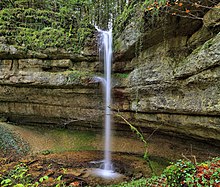Orgeans-Blanchefontaine
| Orgeans-Blanchefontaine | ||
|---|---|---|
|
|
||
| region | Bourgogne-Franche-Comté | |
| Department | Doubs | |
| Arrondissement | Montbeliard | |
| Canton | Maîche | |
| Community association | Pays de Maîche | |
| Coordinates | 47 ° 16 ' N , 6 ° 45' E | |
| height | 390-713 m | |
| surface | 4.83 km 2 | |
| Residents | 44 (January 1, 2017) | |
| Population density | 9 inhabitants / km 2 | |
| Post Code | 25120 | |
| INSEE code | 25433 | |
Orgeans-Blanche Fontaine is a French commune with a population of 44 (as at 1st January 2017) in the Doubs department in the region of Bourgogne Franche-Comté .
geography
Orgeans-Blanchefontaine is located at 470 m , five kilometers west-northwest of Maîche and about 28 kilometers south of the city of Montbéliard (as the crow flies). The village extends in the Jura , on a terrace on the southern slope of the Dessoubre , at the north foot of the heights of Maîche.
The area of the 4.83 km² municipal area covers a section of the French Jura. The northern border runs along the Dessoubre, which flows in a winding course deeply cut into the surrounding Jura high plateaus from southwest to northeast. The steep valley slopes are criss-crossed by limestone bands. From the course of the river, the municipal area extends south to the terrace of Orgeans-Blanchefontaine, which is divided by the Waroly valley cut. This terrain terrace is overlooked by a steep, predominantly wooded slope, on average 200 m high, which leads to the Maîche plateau. The southeastern municipal boundary mostly runs above the steep slope, which is crowned in various places by the rocks of a resistant limestone layer. At 713 m, the highest point of Orgeans-Blanchefontaine is reached on the edge of the height of Le Friolais.
The community consists of the two districts of Orgeans ( 470 m ) and Blanchefontaine ( 500 m ) on the terrace on the southern slope of the Dessoubre as well as a few individual farms. Neighboring municipalities of Orgeans-Blanchefontaine are Vauclusotte , Valoreille and Fleurey in the north, Les Bréseux in the east, Mancenans-Lizerne and Mont-de-Vougney in the south and Battenans-Varin and Cour-Saint-Maurice in the west.
history
In the Middle Ages, Orgeans and Blanchefontaine belonged to the dominion of Saint-Julien . Together with Franche-Comté , both villages came to France with the Peace of Nijmegen in 1678. In 1973 the two previously independent municipalities merged to form Orgeans-Blanchefontaine.
population
| Population development | |
|---|---|
| year | Residents |
| 1962 | 57 |
| 1968 | 41 |
| 1975 | 61 |
| 1982 | 60 |
| 1990 | 44 |
| 1999 | 53 |
| 2016 | 47 |
With 44 inhabitants (as of January 1, 2017) Orgeans-Blanchefontaine is one of the smallest communities in the Doubs department. Throughout the 20th century, the population fluctuated between 40 and 80 people.
Economy and Infrastructure
Until well into the 20th century, Orgeans-Blanchefontaine was a village dominated by agriculture (cattle breeding and dairy farming, arable farming and fruit growing). Even today, the residents live mainly from their work in the first sector. Outside the primary sector there are very few jobs in the village. Some workers are also commuters who work in the surrounding larger towns.
The village is located away from the larger thoroughfares. The main access is from the D39 (road through the Dessoubre valley). Other road connections exist with Maîche, Belleherbe, Vauclusotte and Battenans-Varin.

